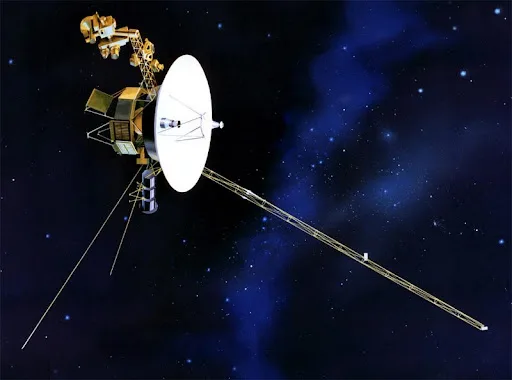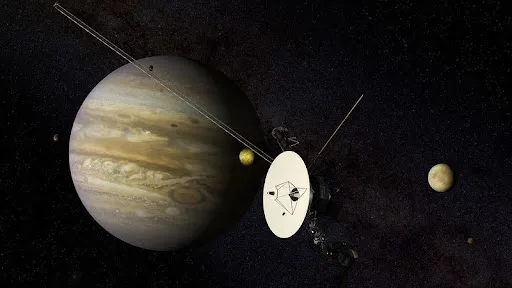Over the relatively short history of space exploration, humanity has already made astonishing progress. We have set foot on the Moon, are getting ready to colonise Mars, and have already sent multiple uncrewed vehicles to far-away space objects. And Voyager 1 mission beats all records in terms of distance traveled and data collected. So, where is Voyager 1 now — the furthest artificial tech that ever set off from our home planet?
Mission Details & Original Mission
The Voyager 1 mission set out towards Jupiter in September 1977 — ironically, several days after than Voyager 2, but the reverse numeration had to do with which of the probes would reach its destination first. The space roamer successfully arrived at its first destination in January 1979, taking the first up-close photos of the gas giant and discovering two of its natural satellites not known of before — Thebe and Metis.
By November 1980, the traveller had already been roaming Saturn’s outskirts. There, it discovered three more moons not visible over telescopes at the time. Besides, the most ‘famous’ picture of our home planet, dubbed A Pale Blue Dot, as well as the entire family portrait of our solar system, also comes from this probe. But does Voyager 1 work now? Yes, and it is still sending reports over enormous distances of space.
Where is Voyager 1 Now?

The probe launched at an enormous speed of 17 km/s or 61,200 km/h, which allowed it to reach its first destination so quickly. Today, it is still moving with roughly the same speed that, however, could have slowed down when the tech was flying by planets in our system and was being affected by their gravitational pull. So, not even NASA can pinpoint its exact coordinates now, but we do know that the traveller is already in the constellation Ophiuchus, at roughly 24.2 billion km from us, and flying ever further.
So, will Voyager 1 leave the solar system? According to some ‘border estimates’, it already has, even though NASA could only confirm it in the early 2010s. And yet, on the scale of the deep cosmos, the distant traveller is only beginning to tap into its immense distances. Voyager 1 light-year distance, for example, has not even reached a full year — and that after roaming the solar system for almost half a century at enormous speeds! Besides, the space between the Voyager and Earth is not constant. It is affected by the Earth’s rotation speed in its orbital axis, which is greater than that of any artificial spacecraft — at least, so far.
How Far Voyager 1 Can Go?
When Voyager 1 left the solar system on August 25, 2012, it was already a huge achievement — nothing of the kind has ever been accomplished before. And yet, the probe can still travel farther — in fact, it is likely that the roamer will keep drifting our galaxy for many light years after all communication with it is lost. So, is Voyager 1 in interstellar space? Yes, and it will remain there for quite a long time because the interstellar distances are so vast it is almost impossible to comprehend them. For example, NASA estimated that in about three centuries, the probe should already reach the Oort Cloud — an area far beyond Pluto’s borders. But it could take thousands more years before the probe travels through this cloud — which means that we would not get any access to measurements it could make on the way even if its electronics still had power supplies left.
But does Voyager 1 use its electronics to keep sending signals now? Yes! Back in 2012, when the space roamer became the first-ever tech to reach interstellar space and send scientific data from the untapped territory. By 2021, it also confirmed the theory that interstellar gas is a more active environment than solar wind.
In May 2022, NASA also experienced a problem with the telemetry data it received from the probe, but before the summer was over, the agency reported having fixed this problem. Today, NASA says that the space roamer should have enough power to last until 2025 at least — possibly even longer. So, there is a chance that the farthest object ever launched so far may still surprise us with new discoveries.
What Will Happen When Voyager Power Runs Out?
The contact with the traveller will be lost, but Voyager 1 will keep roaming the depths of space for many more years unless it gets destroyed by some outside force. But considering the vast rarefied distances, it is very unlikely that it will hit anything. That is why Voyager 1 also has a diplomatic mission — a message to other civilisations should it ever reach any. Of course, translations into 50 human languages may not be enough for alien civilisations to decipher it, but who knows? A chance is a chance.

